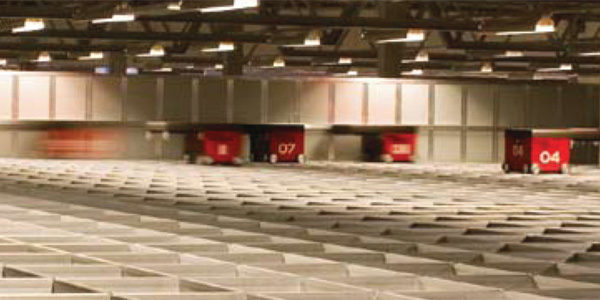AS/RS helps PC supplier reboot

Komplett may not be a name that rings a bell in North America, but the company is well known in Scandinavia, where it has become a leading supplier of PCs, PC components, and other electronic parts. The company, which launched its e-commerce business in 1996, today boasts 675,000 customers, with all sales conducted over the Web. Its product line has grown to include more than 10,000 items, including customer-built PCs. Last year, Komplett shipped 1.4 million orders—an average of one every 23 seconds by its calculations.
That volume, and customers' expectations of fast deliveries, puts a great deal of pressure on the company's central distribution center, located near headquarters in Sandefjord, Norway. And the bigger the company got, the more intense the pressure grew. As time went on, it became harder and harder to meet those expectations, says Pâi Vindegg, the company's chief operating officer.
Part of the problem was capacity, explains Vindegg, who joined Komplett as logistics director in 2003. After nearly a decade in operation, the facility was simply running out of storage space. The other part was productivity—throughput volume had reached a point where the center's manual operations no longer cut it. Clearly, the company would have to make some changes if it hoped to keep up with future demand. So a few years back, Komplett began looking for a way to increase storage capacity and make its operations more efficient, Vindegg says.
The company examined—and rejected—several options. "We looked at making the warehouse bigger. It was possible to do that, but that would not solve our efficiency problem—it would just add more square meters to run around," Vindegg says. "We thought about a greenfield project, but we still needed better tools to work more efficiently. We also looked at mini-loads and cranes, but the existing building lacked the necessary height, so that would still mean a greenfield project."
Problem solved
Eventually, Komplett found a solution that met all of its requirements: an automated storage and fulfillment system. Installing an automated system would allow the company to make better use of its existing space, solving its storage dilemma. And because automated systems are designed to be retrofitted into existing facilities, there would be no need for Komplett to expand its facility or move. Finally, the system promised to deliver the productivity boost the company was looking for.
The system it chose was AutoStore, an automated system designed for operations that require both dense storage and efficient piece and small-case picking. The system, which can be adapted and expanded as needed, features a three-dimensional grid of self-supporting bins that are moved to pick stations by a series of independent robots.
Komplett made the decision to install the AutoStore system in October 2006. Physical preparation began in early 2007, and operations went live in August of that year. Element Logic AS, an integrator in Norway, installed Komplett's AutoStore system. (Swisslog is the exclusive distributor of the system in North America; it also distributes the system in much of Europe.)
Vindegg says that while the construction created some headaches, the DC was able to continue operating throughout the process. The initial installation included a grid 16 bins high, with a total of nearly 16,000 bins, 25 robots, and 17 picking stations. Since then, Komplett has expanded the AutoStore system to some 33,000 bins, 55 robots, and 28 picking stations.
Power grid
To get an idea of how the AutoStore operates, picture battery-powered robotic carts traveling along the top of a large multi-level aluminum grid composed of rectangular cells. Each robot has two sets of wheels that allow it move along either of the grid's vertical axes.
As orders come in, Komplett's warehouse management system (WMS) transmits picking instructions to AutoStore via a wireless network. (Vindegg says the system holds about 700 live tasks in its queue at any one time.) Based on those instructions, the robots use lifts to reach into the grid to retrieve plastic bins containing the appropriate stock-keeping units (SKUs) for delivery to a picking station.
At the stations, workers select items from the bins and then scan the items' bar codes to confirm the picks (a screen at the picking location provides instructions on the quantity of items to pick from each bin). When a worker is done with a bin, the robot returns it to the grid system and delivers another. In the meantime, another bin has been lined up at the picking station, which limits waiting time between picks. Once an order is complete, the worker places the carton on a conveyor for transport to shipping.
Putaway works much the same way, only in reverse. An operator logs in at a station as a putaway user, and adds goods to bins based on instructions from the system.
The bins in the grid do not have preset slotting locations. "Each bin is a location," Vindegg explains. "AutoStore knows which bin is needed and where it is located."
Vindegg adds that one of the things he likes best about AutoStore is the way it almost naturally slots fast movers in the most accessible locations. Bins can be stacked as many as 16 deep, meaning retrieving bins toward the bottom can take time. But the nature of the system is such that the bins used most often stay near the top of the grid, while the others slowly sink to the bottom, he says. "Our statistics show that 90 to 95 percent of what we need is in the three upper layers."
Big boost in efficiency
As for how the system has worked out for Komplett, Vindegg reports that it has resulted in a significant improvement in productivity. Although the addition of new product lines as a result of Komplett's 2008 merger with Torp Computing Group makes it difficult to quantify the actual gains, Vindegg estimates that the AutoStore has boosted efficiency by at least 20 percent. He notes that last year, the company was able to pick and pack 1.4 million orders containing 4.4 million units using just 10 workers to operate the system over 12 eight-hour shifts per week (two shifts per weekday, plus one shift each on Saturday and Sunday).
Although it's happy with the results to date, Komplett continues to fine-tune the system. "This is the kind of project that's never finished," Vindegg says. "We are always doing things to the software, making small adjustments."
Asked what advice he would offer to someone interested in installing this type of system, Vindegg says the secret's in the staffing. "It is important to have competent people—very important. What we have done is take young eager people from our own organization and given them training on the job, given them the technical background on the robots and software. We know there will be a number of system stops every day. Small things could make the system stop for a minute or two or three, but our people are able to get it up and running without calling someone from outside. You need that competence in house."
Related Articles

Copyright ©2024. All Rights ReservedDesign, CMS, Hosting & Web Development :: ePublishing